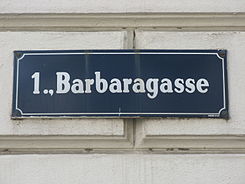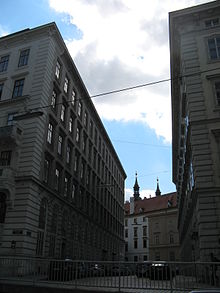Barbaragasse
| Barbaragasse | |
|---|---|
| Street in Vienna Inner City | |
| Basic data | |
| place | Vienna Inner City |
| District | Inner city |
| Created | no later than the 17th century |
| Hist. Names | Barbaragässel |
| Cross streets | Postgasse, Dominican Bastion |
| use | |
| User groups | Car traffic , foot traffic |
| Technical specifications | |
| Street length | approx. 55 meters |
The Barbaragasse located on the 1st Viennese district of Inner City . It was named in 1862 after the nearby Barbara Church .
history
The area of today's Barbaragasse was part of the cemetery of the Dominican monastery , first mentioned in 1368 , the so-called Predigerfreithofes . The area was later owned by the Jesuit order , with a lane between the Barbarakapelle in the north and the landscape school in the south, which was already called Barbaragässel in 1701 . In 1862 it was officially named Barbaragasse .
Location and characteristics
The Barbaragasse leads from the Postgasse in an easterly direction to the Dominikanerbastei . It is run in the opposite direction as a one-way street, with a side lane of the Dominican Bastion leading up to the Barbaragasse, which is at the level of the Bastion, as a ramp. There is no public transport.
The construction of the short street is uniformly early historical . Since the buildings are side fronts and there are no shops or restaurants to be found there, Barbaragasse has the character of a quiet and insignificant side street, in which there are few pedestrians.
building
No. 1 main post
Since 1423 there was a Burse at this point , which was called Burse zur Rote Rose in 1470 and Rosenburse since 1507 (the university was in the immediate vicinity). In 1623 it became the property of the Jesuits, who set up a Barbara chapel there in 1654. After the abolition of the order, Maria Theresa gave the church and the adjoining building to the Greek Catholic Church in 1775 . The seminar called barbarism was intended to train the Greek Catholic clergy in the Habsburg Empire. As early as 1784 the seminary was abolished and a parish was established. From 1849–1854, the main toll building, located north of the church and built in 1767–1773, was combined with the church and the Barbarastift by Paul Wilhelm Eduard Sprenger to form a large contiguous building complex for the main post office. The original buildings were largely preserved up to the 2nd floor, but Sprenger standardized the facades in the early historic style. The formerly baroque church was also redesigned and a Greek-Catholic central seminar was set up.
The building is at the main address Postgasse 8-10.
No. 2, 4 Former printing and publishing house Gerold
In 1623 the Jesuits built the aristocratic landscape school on this site, in its place after the dissolution of the order in 1773 private houses were built. The Gerold printing and publishing company was located here until 1810. In 1852 Eduard van der Nüll and August Sicard von Sicardsburg created today's early historic corner house between the Dominikanerbastei, Barbaragasse and Postgasse. Johannes Brahms lived here in 1867 . The building is at the main address Postgasse 6.
literature
- Richard Perger: streets, towers and bastions. The road network of the Vienna City in its development and its name . Franz Deuticke, Vienna 1991, ISBN 3-7005-4628-9 , pp. 20-21.
- Felix Czeike (Ed.): Barbaragasse. In: Historisches Lexikon Wien . Volume 1, Kremayr & Scheriau, Vienna 1992, ISBN 3-218-00543-4 , p. 250 ( digitized version ).
Web links
Coordinates: 48 ° 12 ′ 33.3 " N , 16 ° 22 ′ 46" E


